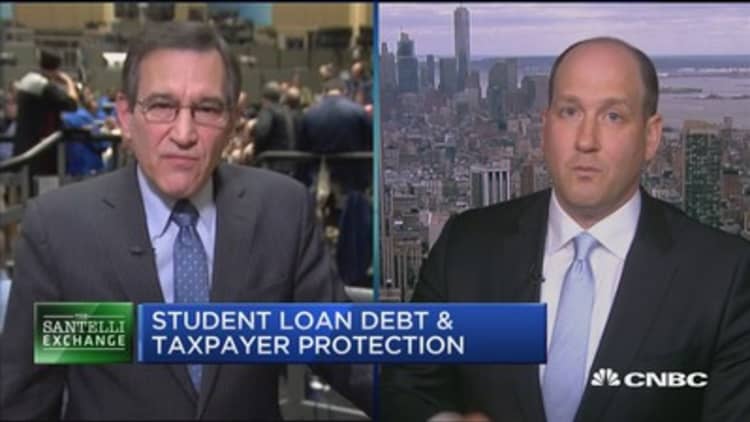
Student loans come with an awful surprise for struggling borrowers: Unlike most other debt, you usually can't get rid of student loans through bankruptcy.
Roughly 44 million Americans owe more than $1.4 trillion in federal student loans. More than 4.2 million borrowers were in default as of the end of 2016, up from 3.6 million in 2015. In all, 1.1 million more borrowers went into or re-entered default last year.
On average, more than 3,000 borrowers default on their federal student loans every day. Student loans are considered in default if you fail to make a monthly payment for 270 days. Your loan becomes delinquent the first day after you miss a payment. Loan servicers report all delinquencies of 90 days or longer to the three major credit-scoring companies. That will hammer your credit score and make it harder to borrow for vehicle or a house.
The number of people who have defaulted on their federal student loans increased 17 percent from 2015 to 2016, according to a Consumer Federation of America analysis of U.S. Department of Education data.
When you default, the student debt sticks around. Defaulted borrowers rack up onerous fees that can increase the amount owed and lengthen the time if takes to repay the loan.
A typical borrower who defaults on a student loan could extend the standard 10-year repayment period by up to seven years and increase the loan balance by up to 25 percent because of collection fees, according to estimates from Mark Kantrowitz, publisher and vice president of strategy for college and scholarship search website Cappex.com.
Here are the steps to take if you are likely to miss a student loan payment or want to get out of default:
1. Ask about forbearance and deferment options
You can receive a deferment or forbearance that allows you to temporarily stop making student loan payments or temporarily reduce the amount you pay. The main difference between forbearance and deferment options is that interest still accrues in forbearance and some types of deferments, which will make your loan balance bigger.
With federal student loans, you can generally defer up to three years if you face financial hardship or if you're enrolled at least half-time at an eligible school. Forbearance for federal student loans is typically granted for up to 12 months.
People with private student loans face limited options compared with federal loans. Some private lenders offer forbearance if borrowers can't make their payments, but it depends on the lender.
Deferment and forbearance aren't automatic. You will have to fill out forms to qualify for these options with your servicer or lender. The sooner you reach out, the better chance you have of finding an option that can help you prevent being delinquent on your loans.
2. Consider an income-based repayment plan
If you have federal student loans, you can qualify for income-based repayment plans.
Income-driven repayment plans allow borrowers to pay only a certain percentage of their income on their student loans each month rather than what they owe under a standard 10-year repayment plan. On the other hand, if you can afford to pay more on your federal student loans, you should consider doing so because this will save you more on interest costs over the life of your loan.
Depending on the repayment plan, your student loan will be forgiven after 20 or 25 years. Keep in mind that any student debt forgiven is considered taxable income under current law.
The percentage of federal student loan borrowers enrolled in repayment plans has quadrupled over the past four years from 5 percent in 2012 to nearly 20 percent last year. The Department of Education already spends about $11 billion on income-based repayment plans each year.
It was already a difficult process to apply for income-driven repayment plans with the IRS data-retrieval tool and now that process is more difficult.Mark Kantrowitzpublisher and vice president of strategy at Cappex.com
One drawback to income-based repayment plans is that you have to reapply every year to qualify for lower payments. To make matters worse, the IRS data-retrieval tool that helps borrowers apply for these repayment plans has been shut down since early March over concerns about cybersecurity.
"It was already a difficult process to apply for income-driven repayment plans with the IRS data-retrieval tool and now that process is more difficult," Kantrowitz said. The Department of Education said that the tool will be available for borrowers to use for income-based repayment plans later this month.
Check out the Department of Education's repayment estimator to compare what your monthly payments would be under income-driven repayment plans.
More from College Game Plan:
The 3-minute tool to calculate your actual college costs
What JPMorgan CEO Dimon gets wrong about the student debt crisis
You can save thousands with this student debt strategy
Your loan servicer may not tell you about income-based repayment plans.
More than 90 percent of the borrowers who rehabilitated a defaulted loan with their servicer were not enrolled in income-based repayment plans, according to a new report from the Consumer Financial Protection Bureau. The CFPB found that those troubled borrowers who did not enroll in a repayment plan were five times more likely to default for a second time.
The bureau has called for loan servicers to make the transition from default to an income-based repayment plan easier for borrowers. Last year, the Department of Education changed the rules to penalize loan servicers when accounts they manage go delinquent and default, but those metrics exclude borrowers who defaulted before the new rules.
"For far too many borrowers, the dream of a fresh start turns into a nightmare of default and deeper debt," said CFPB Student Loan Ombudsman Seth Frotman.
The Trump administration is considering replacing the current five income-based repayment plans with a single plan, according to budget documents obtained by The Washington Post.
3. Fix your defaulted student loans immediately
If you have defaulted on your student loans, you have three options to correct the problem:
You can pay your loan in full. This isn't a reasonable option for most borrowers, but might work if the loan has a small balance. Full payment will get the loan servicer off your back and improve your credit score quickly.
"Rehabilitate" your defaulted student loans. To rehabilitate a loan, you must agree in writing to make nine monthly payments within 20 days of the due date during a 10-month period. Once your loan is rehabilitated, you will regain eligibility for benefits, such as deferment, forbearance, the option to use an income-based repayment plan and loan forgiveness. You also will be eligible to receive additional federal aid.
Consolidate your federal student loans. Loan consolidation allows you to pay off one or more federal loans with a new federal loan. The interest rate on the loan will be a weighted average of the rates on your existing loans. You must make three consecutive, on-time monthly payments on a defaulted loan before you can consolidate it.
Student loan defaults are avoidable if you work with your loan servicer or private lender before the situation becomes a crisis. If you don't, the debt will likely follow you the rest of your financial life.




